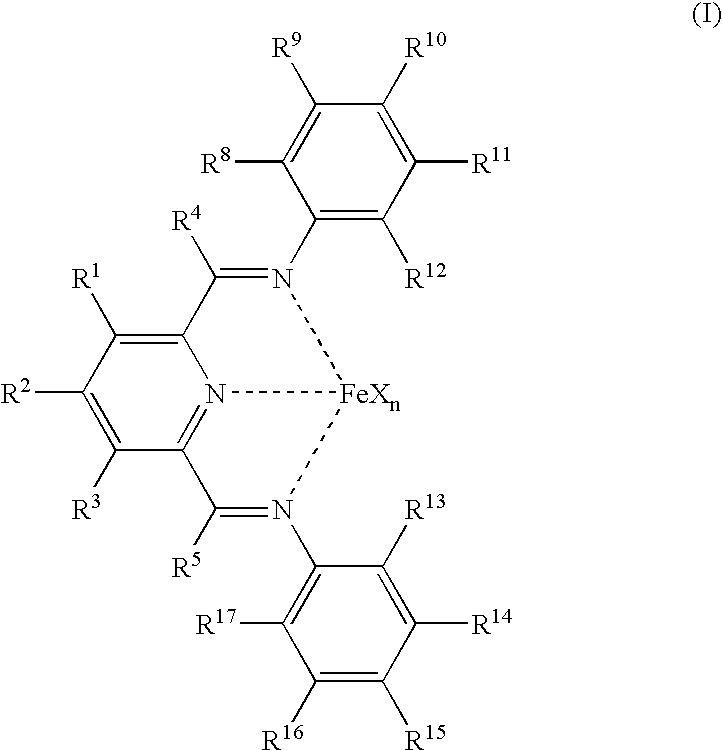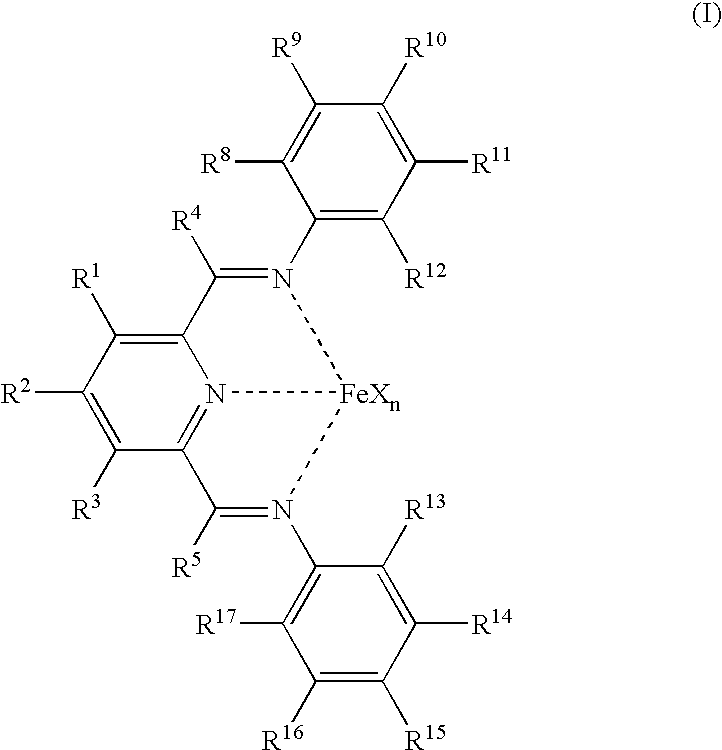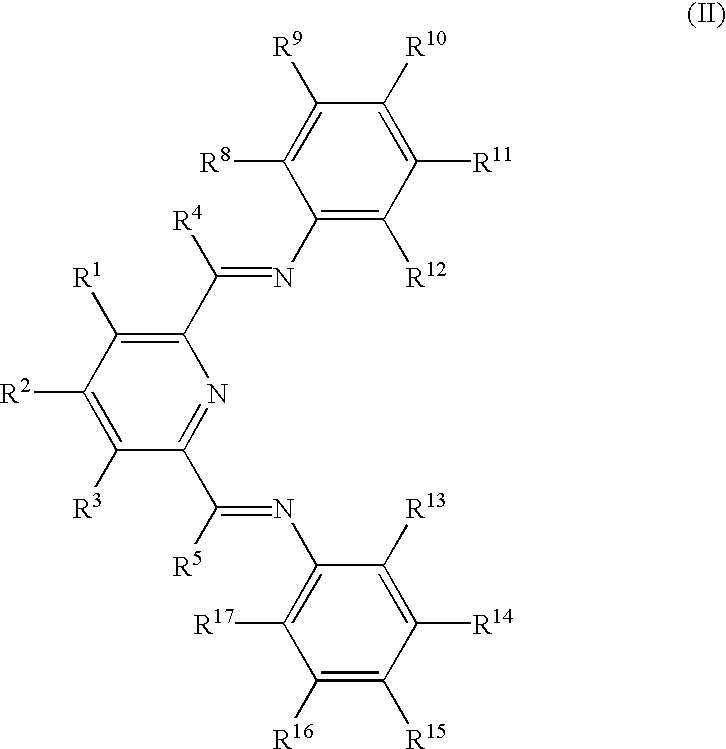Manufacture of alpha-olefins
- Summary
- Abstract
- Description
- Claims
- Application Information
AI Technical Summary
Benefits of technology
Problems solved by technology
Method used
Image
Examples
example 1
Preparation of 2,6-bis-[1-(2-methylphenylimino)ethyl]pyridine, (VII)
One g of 2,6-diacetylpyridine and 3.0 ml of o-toluidine were added to an Erlenmeyer flask with 20 ml of methylene chloride. A stirbar and 5 drops of 97% formic acid were added, and the flask was sealed and the solution was stirred for 40 hours. The solvent was then removed in vacuo, and the flask was placed in the freezer at -30.degree. C. The resulting viscous oil was washed with cold methanol, and a yellow solid formed and was isolated by filtration and identified by .sup.1 H NMR as the desired product (959 mg, 45.9%). .sup.1 H NMR (CDCl.sub.3): .delta.8.38(d, 2, H.sub.pyr) 7.86(t, 1, H.sub.pyr), 7.20(m, 4, H.sub.aryl) 7.00(t, 2, H.sub.aryl), 6.67(d, 2, H.sub.aryl) 2.32 (s, 6, N.dbd.C--CH.sub.3) 2.10(s, 6, CH.sub.3 aryl).
example 2
Preparation of 2,6-bis[1-(2-ethylphenylimino)ethyl]pyridine, (VIII)
One 9 of 2,6-diacetylpyridine and 3.0 ml of 2-ethylaniline were added to a round-bottom flask with 30 ml of methanol. A stirbar and 5 drops of 97% formic acid were added, and the flask was sealed and the solution was stirred for 24 hours at 50.degree. C. The flask was then cooled to room temperature and placed in a freezer at -30.degree. C. After 1 day, yellow crystals had formed. The crystals were isolated by filtration and identified by .sup.1 H NMR as the desired product (1.25 g, 55.2%). .sup.1 H NMR (CDCl.sub.3): .delta.8.38(d, 2, H.sub.pyr), 7.86(t, 1, H.sub.pyr), 7.20(m, 4, H.sub.aryl), 7.07(t, 2, H.sub.aryl), 6.65(d, 2, H.sub.aryl), 2.49(q, 4, H.sub.benzyl), 2.35(s, 6, N--C--CH.sub.3), 1.14(t, 6, CH.sub.2 CH.sub.3).
example 3
Preparation of 2,6-bis[1-(1-isopropylphenylimino)ethyl]pyridine, (IX)
One g of 2,6-diacetylpyridine and 3.0 ml of 2-isopropylaniline were added to an Erlenmeyer flask with 20 ml of methylene chloride. A stirbar and 5 drops of 97% formic acid were added, and the flask was sealed and the solution was stirred for 40 hours. The solvent was then removed in vacuo, and the flask was placed in the freezer at -30.degree. C. The resulting viscous oil was washed with cold methanol, and a yellow solid formed and was isolated by filtration and identified by .sup.1 H NMR as the desired product (1.63 g, 66.8%). .sup.1 H NMR (CDCl.sub.3): .delta.8.38(d, 2, H.sub.pyr), 7.32(d, 2, H.sub.aryl), 7.18(t, 2, H.sub.aryl), 7.10(t, 2, H.sub.aryl), 6.63(d, 2, H.sub.aryl), 3.00(sept, 2, CH(CH.sub.3).sub.2), 2.37(s, 6, N.dbd.C--CH.sub.3), 1.18(d, 12, CH(CH.sub.3).sub.2).
PUM
| Property | Measurement | Unit |
|---|---|---|
| temperature | aaaaa | aaaaa |
| temperature | aaaaa | aaaaa |
| weight percent | aaaaa | aaaaa |
Abstract
Description
Claims
Application Information
 Login to View More
Login to View More - R&D
- Intellectual Property
- Life Sciences
- Materials
- Tech Scout
- Unparalleled Data Quality
- Higher Quality Content
- 60% Fewer Hallucinations
Browse by: Latest US Patents, China's latest patents, Technical Efficacy Thesaurus, Application Domain, Technology Topic, Popular Technical Reports.
© 2025 PatSnap. All rights reserved.Legal|Privacy policy|Modern Slavery Act Transparency Statement|Sitemap|About US| Contact US: help@patsnap.com



